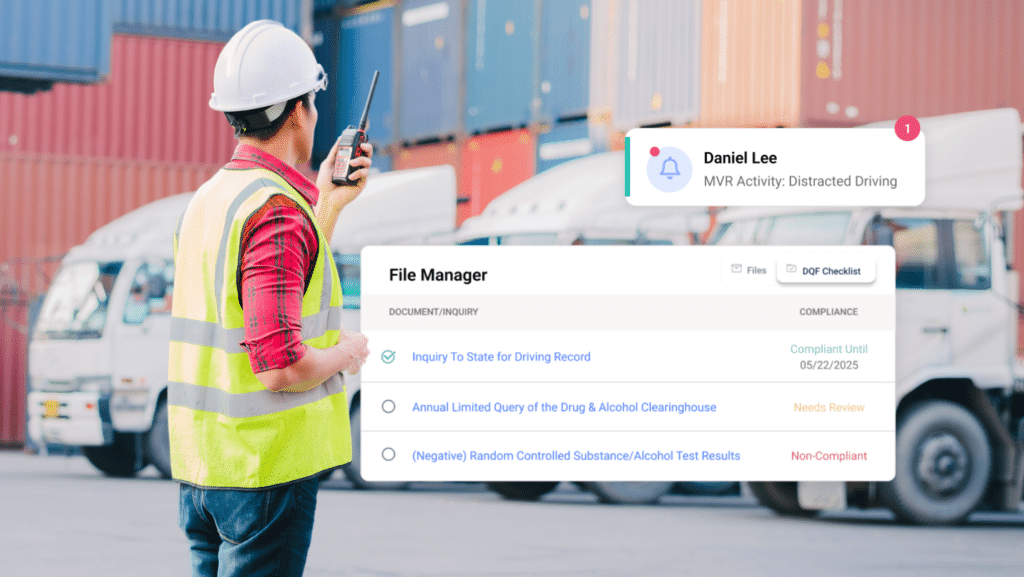Top Fleet Management Trends to Watch in 2025

Are your safety practices keeping up with new fleet management trends? With advancing technology and stricter standards, staying informed and updating your programs is essential for creating safer teams. In 2025, new innovative tools and strategies will empower managers to improve driver safety, enhance compliance, and foster a strong safety culture. Here are the top driver safety trends that will shape fleet management in the year ahead:
8 Fleet Management Trends in 2025
1. Better Access to Real-Time Safety Data
Real-time safety data is set to become the cornerstone of fleet management trends in 2025. With the rapid advancement of telematics, connected vehicles, and driver technologies, fleet managers will have unprecedented access to critical information. Immediate access to driver performance and vehicle health data will continue to help managers make quick and informed decisions to prevent accidents, reduce downtime, and ensure compliance.
2. Telematics for Monitoring Driver Behavior
Telematics technology is advancing, offering deeper insights into driver behavior and vehicle performance. With real-time data on speeding, harsh braking, and other risky behaviors such as distracted driving, fleet managers can proactively address unsafe practices. In 2025, telematics will have a deeper integration of artificial intelligence and machine learning and become more essential for monitoring and coaching drivers.
3. Proactive Fatigue Management
Fatigue management tools, such as in-cab alert systems and AI-powered monitoring, are becoming more sophisticated. These tools use eye-tracking and facial recognition to detect signs of driver drowsiness, alerting drivers to take breaks and notifying fleet managers when necessary. In 2025, fatigue management technology will become a staple for fleets to keep drivers alert and safe on the road.
The NHTSA estimates that fatigue-related crashes cost society $109 billion annually. Between 2017-2021, 17.6% of all fatal crashes involved a drowsy driver.

4. Advanced Driver Assistance Systems (ADAS)
ADAS features such as lane-keeping assistance, automatic braking, and adaptive cruise control have proven effective in reducing accidents. By 2025, ADAS technology will be more accessible, and more fleets will incorporate it to enhance driver safety. These systems not only protect drivers but also help reduce collision-related costs and improve overall fleet safety metrics.
The National Safety Counsil estimates that ADAS technologies can potentially prevent or mitigate 1.69 million injuries (about 60% of total traffic injuries). The majority of the injury reduction is achieved by forward collision prevention and lane keeping assist.
5. Automated Compliance Management
Keeping up with compliance regulations is a time-consuming yet essential aspect of fleet management. Automated compliance tools, such as driver qualification file management systems and MVR monitoring, are becoming crucial for staying compliant without the administrative burden. In 2025, more fleet and safety managers will invest in software that automates tracking driver compliance, DQF management, and other regulatory needs, allowing for a seamless and auditable process.
Read more: Driver Qualification Files: 5 Reasons to Go Digitally

6. Increased Demand for MVR Monitoring
Traditional annual MVR pulls are quickly becoming outdated, giving way to more advanced and efficient technology like MVR Monitoring. What makes this technology different is its ability to send alerts on new driver MVR violations, suspensions, and risky behaviors, ensuring that fleet managers are always informed of their drivers’ current status. Read more: Continuous License Monitoring FAQs
In 2025, companies will turn to MVR Monitoring to automate driver reviews and catch violations that traditional MVR checks might miss. The ability to act quickly on driver violations or risky behavior enables fleet managers to address potential issues before they escalate, reducing accident and liability exposure.
7. Enhanced Driver Well-being
Driver well-being has become a top priority as fleets recognize the link between driver health and performance. Programs aimed at improving physical and mental well-being, fatigue management, and stress reduction will continue to gain traction. In 2025, more fleets will introduce wellness programs, monitor driver health, and provide resources to support driver welfare, leading to higher retention and lower accident rates.
8. Safety-Focused Incentive Programs
Recognizing and rewarding safe driving is an effective way to motivate drivers. In 2025, more fleets will implement incentive programs that reward safe behavior, using metrics from telematics and MVR data to track performance. Safety-focused incentives not only reduce accident rates but also promote a positive safety culture across the fleet.
2025 More Safety & Innovation
The 2025 fleet management landscape will be driven by advanced technology and a strong focus on safety. With tools like AI-powered telematics, real-time MVR Monitoring, and automated compliance systems, fleet managers will better track driver behavior, reduce risks, and ensure compliance.
The first step to achieving fleet safety is staying ahead by embracing new technologies and moving beyond outdated practices. Learn more about our innovative driver safety management solutions. MVR Monitoring, Fleet Driver Training, DQF Management, and more.






